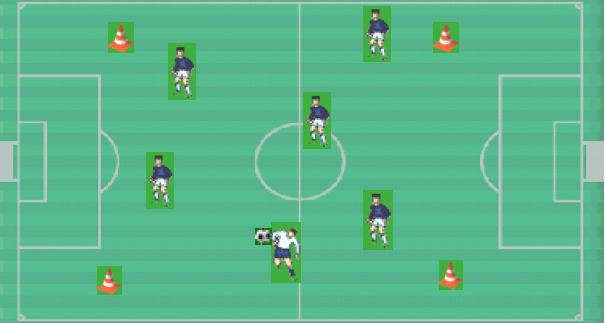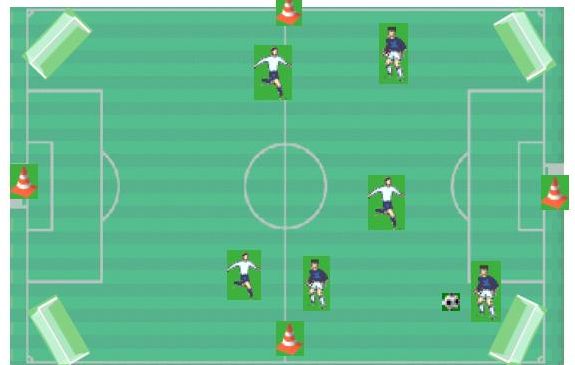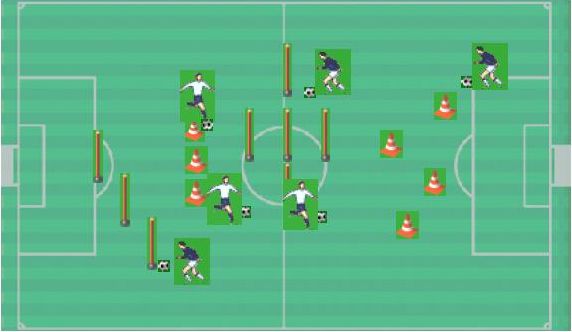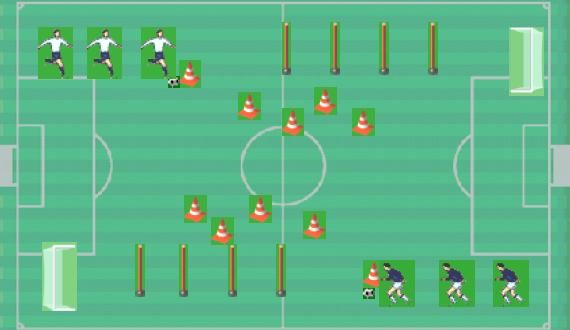Games
Simple catcher: There are 16 to 24 players in an area of 20 by 20 m. An appointed player with a ball on the ground indicates that he is the catcher. The player he catches while running becomes the catcher.
Variations: There is more than one catcher, or the area is smaller or bigger. The catcher has no ball; the one he catches gives him his ball and becomes the catcher.
Half-minute catcher: There are 16 to 24 players in an area of 15 by 15 m. The appointed player’s task is to catch as many players as possible within half a minute. Only the catcher has no ball. The caught player squats down.
Variations: Changing the time (cc. 20 to 50 seconds); the area is smaller or bigger; everyone has a ball; only the catcher a ball.
Catcher with kicking at: There are 16 to 24 players in an area of 20 by 20 m. An appointed player with a ball in his hand indicates that he is the catcher. The player he kicks the ball at while running becomes the catcher.
Variations: There is more than one catcher; the area is smaller or bigger. The ball can be kicked only by right outside or left inside foot.
Catcher with dribble:
There are 16 to 24 players in an area of 20 by 20 m. An appointed player with a ball on the ground indicates that he is the catcher. The player he kicks the ball at while dribbling becomes the catcher.
Variations: There is more than one catcher; the area is smaller or bigger. The ball can be kicked only by right inside or left inside or toe.
Simply get the ball: There are 16 to 24 players in an area of 20 by 20 m. Everyone has a ball, except the catcher. The one he takes the ball away from becomes the catcher.
Variations: There is more than one catcher who has no ball; the area is smaller or bigger.

Catcher games:
- catcher with ball
- catcher in straddle
- Ice catcher
- The catcher always has the ball
Note: None of the children should be standing, everyone should participate actively in the game
Header games from 7 to 14 years
Simple catcher: There are 16 to 18 players in an area of 15 by 15 m. An appointed player with a ball in the hand indicates that he is the catcher. The player he heads the ball onto while running becomes the catcher.
Variations: There is more than one catcher; the area is smaller or bigger.
Half-minute catcher: There are 16 to 18 players in an area of 15 by 15 m. The appointed player’s task is to head the ball onto as many players as possible within half a minute. The caught player squats down.
Variations: Changing the time (cc. 20 to 50 seconds); the area is smaller or bigger.
Collector header catcher: There are 16 to 18 players in an area of 15 by 15 m. An appointed player with a ball in the hand indicates that he is the catcher. The player he heads the ball onto while running takes a ball and becomes a catcher too. The winner is the one who remains the last.
Variations: Playing for a given time; the area is smaller or bigger.
Line header catcher: Field of play, the lines within the penalty area, with 16 to 18 players. The players can flee only on these lines. The appointed catchers can also chase their mates only on these lines. The winner is the one who was a catcher the fewest times.
Variations: Using the handball and the basketball court lines indoor; with more catchers; advancing on the lines with various tasks (e.g. dwarf walking, hopping on both legs); several escape routes can be made by lengthening the lines of the goal area.
Get rid of the balls: There are 16 to 18 players in two teams facing each other, with 3 balls each, in an area of about 10 by 20 m. The winner is the team that head all the balls onto the opponent’s half.
Variations: more or less balls; bigger or smaller area.
Header game, 2 against 2, or 3 against 3, on a goal of 5 by 2 m:
In an area of 5 by 10 m, the ball coming from the goal can be sent to the opponent’s goal by both the offensive and the defensive teams.
Variations: the number of passes is unlimited within an attack; the ball coming from the goal can be returned to the goalkeeper twice if it is inaccurate; if the defensive team heads into the header of the offensive team, and the ball lands on the ground, the play is continued from the place of landing; the goal stuck /stukk/ counts double.
Header game, 3 against 3 on a goal of 5 by 2 m: The ball coming from the goal can be sent to the opponent’s goal by both the offensive and the defensive teams.
Variations: the defensive team defends only with 2 players; the number of passes is unlimited within an attack; the ball coming from the goal can be returned to the goalkeeper twice if it is inaccurate; if the defensive team heads into the header of the offensive team, and the ball lands on the ground, the play is continued from the place of landing; the goal stuck /stukk/ counts double.

3 against 3 play on 2 small goals on each side
- if the ball gets out of the field of play, it can be played again by passing in
- after a goal, players must go back to their own half
OBJECTIVE: to develop players’ creativity
Note: Encourage wide play, creating extended goal opportunities.

Technical exercises with ball
- Dribble the ball: by hand or foot (outside, inside), do various exercises at a signal (e.g. stop the ball by the sole)
- faking
Objective: to control the ball
Note: constant correction of mistakes (foot positions)

Skill competitions with ball between two teams
- Dribble the ball: with hand or foot in a straight line or slalom
- faking
Objective: to control the ball
Note: aim at fast but accurate performance

Coordination with and without ball, shooting on goal
- Dribble the ball: with hand or foot in a straight line or slalom
- Faking against line defence, shooting on goal
Objective: to control the ball
Note: aim at fast but accurate performance, take care of coordination